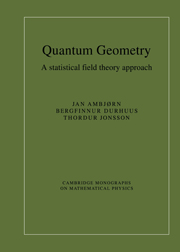2 - Random walks
Published online by Cambridge University Press: 20 October 2009
Summary
The role of random walks as a theoretical tool in physics dates back at least to the explanation of the origin of Brownian motion at the turn of the century. The universal features of the large-scale phenomena associated with random walks are already transparent in Einstein's derivation of the diffusion equation in his famous 1905 paper on Brownian motion. Ever since, theories of random walks have played an increasingly important role in virtually every branch of physics and now form the basis of statistical theory in general in the subject of stochastic processes. The appearance of random walks in elementary particle physics was mediated by Feynman's path integral formulation of quantum theory, and a mathematically rigorous approach to the subject was made possible by the introduction of Euclidean quantum field theory in the 1960s building on Wieners's earlier work on random walks and the diffusion equation.
We start in the next three sections by introducing various discrete random walk models describing the propagation of scalar particles in space-time. We pay particular attention to critical behaviour in these models and their universality properties: many different discrete models give rise to the same continuum limit. As explained in the Introduction we are primarily interested in viewing random paths as geometric objects. Hence, we focus on such aspects as reparametrization invariance which are usually not stressed in the more standard treatments.
- Type
- Chapter
- Information
- Quantum GeometryA Statistical Field Theory Approach, pp. 11 - 65Publisher: Cambridge University PressPrint publication year: 1997



